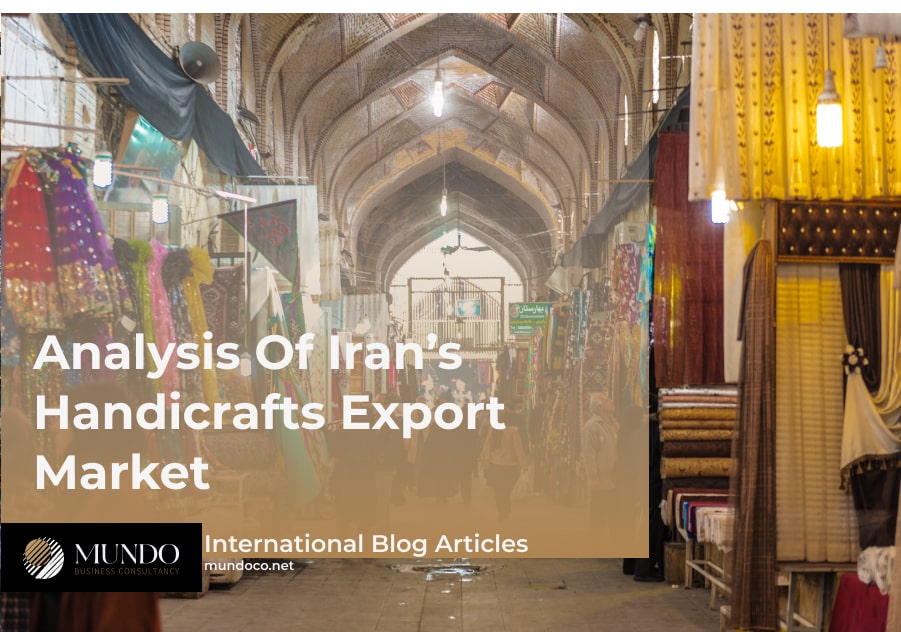Iran’s handicrafts are the origin of the taste and creativity of artists who, with the help of hands and hand tools, distinguish the product from its similar machine-made product. This industry is the result of experience gained from thousands of years of rich Iranian culture and civilization, which can help the economic development of the country. This art industry, without dependence on oil, has the advantage of globalization in terms of exports and increasing productive employment. Of course, it is not possible to achieve the self-sufficiency of handicrafts and the successful development of its export in a decent manner only by considering the cultural and historical aspects. Rather, economic stagnation, embargo, reduced investment, weak and temporary support, weak technology and export foundations, weak managerial factors, local and extra-local institutions, and weak economic foundations of producers, weak executive factors such as: low-quality packaging, transportation and lack of The comprehensive database is one of the things that have been major obstacles in the development of Iran’s handicraft exports in the past years.
As we know, the easiest and least risky way to enter foreign markets is export. Selling through export leaves the least allocation of facilities and the least changes on the internal plans of the companies. Export is one of the important business activities for the health of the national economy of countries. Exports significantly contribute to the growth of employment, trade balance, economic growth, and raising the standard of living of the people. Export also plays a key role in obtaining competitive profitability in companies and turbulent market situations due to improving the financial situation, increasing the utilization of capacities and raising the technology standard and achieving proper performance.
UNESCO has a definition of handicrafts, which are: products that are made entirely by hand or with the help of tools, the most important part in the production of the finished product should be the artisan’s handiwork. The use of mechanical tools is allowed. Handicrafts are made from raw materials and in unlimited quantities. These products may be instrumental, aesthetic, artistic, creative, cultural, decorative, practical, traditional, or religiously and socially symbolic and important.
The general characteristics of handicrafts from the point of view of the World Intellectual Property Organization (WIPO) are as follows:
– Using simple tools to make them
– No need for complex technical knowledge compared to other industries
– Non-similarity and imitation of manufactured products
– It is rooted in the culture, belief, beliefs, customs of the region
– The possibility of supplying most of the raw materials for consumption from domestic sources
– Ability to supply to global markets as a cultural and artistic product
– Helping to develop the tourism industry and spread cultural values
– Low investment and high usage
– High added value of production
– Capability of practical aspects of product design
– Easier development and relocation of the workshop (production centers)
– Ease of transfer of experience and production technical knowledge
Handicraft trade with a high contribution to creating employment, low production cost, variety of production and no need for extensive infrastructure is one of the foundations that can play a major role in economic growth and development and increase in foreign exchange earnings of the country. India is the most successful country in the world in exporting handicrafts. India exports about 5 billion dollars of handicrafts annually, and the UAE is one of India’s important targets. The details of India’s handicrafts exported to the world are as follows:
Artistic metal goods (18.5 percent), wooden goods (15.3 percent), hand-printed textiles and scarves (12.4 percent), non-genuine jewelry (5.7 percent) are other key categories that have a high share in handicraft exports from India.
Despite the high capacity of exporting handicrafts, Iran has a much weaker position compared to India. Iran’s non-oil exports in 2019 amounted to 113.6 million tons and were worth about 35 billion dollars, of which only 126 million dollars were allocated to the export of handicrafts. This amount is only about 0.4%, less than 0.5% of the total non-oil exports in the past years. Also, the exporters of Iranian handicraft luggage that tourists take with them abroad are also estimated at around 100 million dollars, which is an approximate amount and cannot be measured. The most important exports of Iran include carpets, underlays, and carpets, because they are very competitive in terms of role, size, and price, and their dimensions are designed to fit modern lives. Our wooden and handmade furniture is one of the fields that has a special place in the group of handicraft export goods. Pottery, ceramics, glass and traditional ornaments that are handmade are accepted in the world markets. Also, sculptures and other decorative objects made of hand-made pottery are the second most exported handicrafts of Iran, weighing 7.7 thousand tons and valued at over 11 million dollars. , Oman and Qatar.
Solutions to promote the export of Iranian handicrafts:
– Finding the target market, marketing and advertising necessity in different countries
Branding plays an important role in global markets
– Standardizing and improving the quality of product packaging
– To supply quality goods
– Turning Iran into a market for packaging and exporting handicrafts of neighboring underdeveloped countries such as Afghanistan, Iraq, Pakistan, etc.
– Participation in international handicraft festivals and events
– Reviewing and analyzing the export statistics of these industries and comparing them with the world situation
– Establishing relationships with commercial intermediaries in embassies
– Calculated division of countries based on the request of different handicrafts
Diagram of the necessary components for a successful export
According to the Iranian customs statistics, the UAE was the major buyer of Iranian carpets in 2019 and is one of the most prominent Arab and international importers of Iranian handwoven carpets. It is estimated that the UAE imports about 60 million dollars of handwoven carpets from Iran every year, but now the sanctions and problems of the FATF reduce the volume of Iran’s exports every year. In addition to solving Iran’s international export problems, the Dubai Village World Fair is also held in Dubai every year with the participation of more than 90 countries, including Iran, and has more than 7 million visitors, which is considered a valuable opportunity for the export of Iranian handicrafts. Iran’s handwoven carpets, which enjoyed a good position in Iran’s non-oil exports during the past decades and had many fans in the United States, the United Arab Emirates, China, etc., were unfortunately affected by the withdrawal of the United States from the JCPOA, as well as the problems caused by sanctions and the spread of the Corona virus and the entry of competitors. It is new and in the first 4 months of 2019, it has made the record of the lowest amount of exports in 40 years. America has been one of the main export destinations of Iranian carpets in the past decades, but after the withdrawal of this country from the JCPOA and the return of sanctions, it can be said that 25% of the handwoven carpet export market has been lost. Other countries such as Germany, United Arab Emirates, Japan, Lebanon and sometimes England are other destinations for Iranian handwoven carpets. In fact, last year we saw a very sharp drop in the export of Iranian carpets. So that with the decrease of 72 million dollars in exports compared to 2017, we saw the lowest amount of exports in the last 40 years. In the 4th month of 2019, unfortunately, we witnessed the export of handwoven carpet worth 15 million dollars, which seems that this year we will not reach the export amount of last year, and the downward trend of exports will continue, and if the problems we were facing before the sanctions, such as incorrect domestic policies in the industries Small and medium production and the field of handwoven carpets, which is different from other business areas in terms of nature and identity, we will continue to face the downward trend of the export of handwoven carpets. We should know that markets like China and India are far ahead of Iran in the export of handicrafts, and it has taken over a major part of the world market. Now, we cannot draw a clear vision of carpet exports for the current year, because both domestic and foreign policies are not in favor of exports, especially the export of Iranian carpets. With Iran’s neglect of the income-generating and job-creating capacities of hand-woven carpets, countries such as Egypt, Pakistan and Turkey have entered the field of production in this industry with government support and have introduced themselves to the world in a short time.
So that the export of Pakistan’s handwoven carpet, which was worth 66 million dollars in 2018, has increased to 80 million dollars in 2019, and the export of Turkish handwoven carpets has increased from 42 million dollars in 2018 to 47 million dollars in 2019. India also increased the export of handmade carpets by 5 million dollars from 314 million dollars in 2018 to 319 million dollars in 2019.





